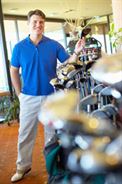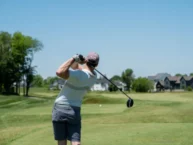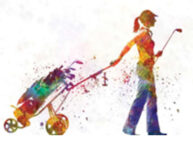While we were playing golf in ireland, my golf partner, Noreen, fell madly in love with the new Ping clubs she had rented. She’s been playing with a set of old Henry Griffiths that were perfect for her when she was first fitted for clubs 15 years ago! But times and technology have changed dramatically and it is more than time that she should think about getting fitted again. Noreen is a very savvy shopper and wants these new golf clubs to be the best for her game, so she’s decided to go to her local golf pro who is a trained expert and will fit her for Pings. Not only does she get clubs that really work for her, but she is guaranteed to actually get the Ping clubs she wants. This is the way to go.
I hate to say it, but the only way you can be sure you are getting real Ping golf clubs is to get fitted from a golf pro  who sells the real thing, or from a reputable retailer. There are just too many scam artists pushing counterfeit clubs onto unsuspecting golfers! And it’s easy to be fooled. Everything about the fake club looks real. Color, weight, they are all really close to the original. But subtle differences make a big difference in performance. It doesn’t matter which club maker you are looking at: Callaway, Ping, TaylorMade… they are all being copied by people looking to make a quick buck by selling inferior knock-offs.
who sells the real thing, or from a reputable retailer. There are just too many scam artists pushing counterfeit clubs onto unsuspecting golfers! And it’s easy to be fooled. Everything about the fake club looks real. Color, weight, they are all really close to the original. But subtle differences make a big difference in performance. It doesn’t matter which club maker you are looking at: Callaway, Ping, TaylorMade… they are all being copied by people looking to make a quick buck by selling inferior knock-offs.
So where are these scam artists? A lot of them are on the internet, on ebay and Craig’s list.
What are the warning signs? What are the signals that you should look for that tell you STAY AWAY! ???
- The deal seems too good to be true. The price difference between the suggested retail price from the manufacturer and the internet dealer is significant. If it’s too good to be true… it probably is.
- It’s hard to tell from photographs if what you are buying is the real thing. The best way to buy is to compare the new club with one you know is real. This is not possible when buying from unknowns on the net. If you are buying from a used sports equipment store, or open air market, check the club for manufacturer’s information, and compare the clubs with those you know are real.
- If the item is shipped from a distant location, or there is scant contact information available on the site to make it difficult to return an item, or check on shipping schedules, that’s a clue that the item might be counterfeit.
Buying new clubs for your golf game is an expensive proposition no matter how you slice it. And it’s understandable that we would all want to shop around and get the best deal possible. But why take a chance and throw away your money on what could be a set of inferior club look-alikes? They may be cheaper, but they won’t be better for your game.
You want a new set of Pings? Go get fitted for them from a pro or retailer who knows what he or she is doing, and buy the real thing. Your game will improve and your money won’t go down the drain after a scam artist.
Here are a few articles I found on the internet that deal with the growing problem with golf club counterfeits. If you’re looking to buy new clubs, you might want to take a few minutes to read these.




